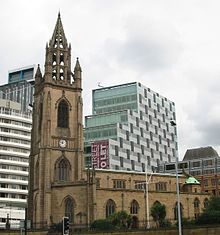Church of Our Lady and Saint Nicholas, Liverpool
| Liverpool Parish Church | |
|---|---|
| Church of Our Lady and Saint Nicholas | |
| St Nick's or The Sailors' Church | |

The Church of Our Lady and Saint Nicholas
|
|
| 53°24′25″N 2°59′41″W / 53.4070°N 2.9948°WCoordinates: 53°24′25″N 2°59′41″W / 53.4070°N 2.9948°W | |
| Location | Liverpool |
| Country | England |
| Denomination | Church of England |
| Churchmanship | Modern Catholic |
| Website | www |
| Architecture | |
| Architect(s) | Edward C. Butler (church) Thomas Harrison (tower) |
| Years built | 1811 (tower) March 1949 (church) |
| Completed | 1815 (tower) 1952 (church) |
| Clergy | |
| Rector | The Revd Crispin Pailing |
| Assistant priest(s) | The Revd David Baverstock The Revd Michelle Montrose |
| Honorary priest(s) | Fr Paul Nener |
The Church of Our Lady and Saint Nicholas is the Anglican parish church of Liverpool. The site is said to have been a place of worship since at least 1257. The church is situated close to the River Mersey near the Pier Head. The Chapel of St Nicholas (Patron Saint of Sailors) was built on the site of St Mary del Quay, which in 1355 was determined to be too small for the growing borough of Liverpool. It is recorded in the National Heritage List for England as a designated Grade II listed building, and is an active parish church in the diocese of Liverpool, the archdeaconry of Liverpool and the deanery of Liverpool North. The church was once the tallest building in Liverpool at 53 metres from 1813–1868 when surpassed by the Welsh Presbyterian Church in Toxteth.
In 1207 Liverpool received its charter from King John. By 1257 a small stone chapel known as St Mary del Quay had been built. It probably stood near the site of the present tower, overlooking a quay on the River Mersey. The chapel was used as the main centre of worship until 1355. A new chapel dedicated to St Mary and St Nicholas was built on land granted to the burgesses by the Duke of Lancaster. It was under construction for more than a century.
In 1361 a plague hit the town and the Bishop of Lichfield and Coventry licensed the burial ground. The chapel was consecrated the following year. By the late 15th century, a north aisle, the same size as the original nave, had been added, and three chantry altars had been established. Each chantry had its own priest paid for by a wealthy patron. In 1515 a fourth chantry was built.
...
Wikipedia
